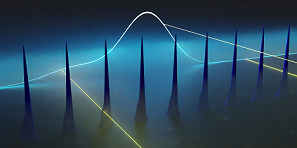Researchers at ETH Zurich have demonstrated direct femtosecond pulse emission from a QCL in the mid-infrared region. The demonstration, which the ETH Zurich researchers reported is the first of its kind, opens the possibility for novel applications of ultrashort laser pulses.
The team was led by Ph.D. student Philipp Taschler and colleagues in the research group of ETH Zurich professor Jerome Faist, who was part of the team that introduced the QCL in 1994 while at Bell Laboratories.
Quantum cascade lasers, a type of semiconductor laser, support numerous applications in the mid-infrared range (25-100 THz). Until the current work, however, QCLs have been unable to deliver ultrashort pulses. This is because QCLs generate mid-infrared radiation directly — that is, they do not rely on converting light from higher to lower frequencies, which is typically an inefficient process that limits the power levels that can be achieved.
The primary bottlenecks for generating ultrashort pulses with QCLs are the fast dynamics of the active medium inside the cavity, which is where the laser pulse is formed. The fast dynamics of the active medium in the cavity prevents high-power pulses from building up.
Though there are ways around this limitation, pulses generated by mid-infrared QCLs have until now been limited to picosecond length and subwatt power.
According to the researchers, the methods they used to compress pulses outside the cavity are well established. In the work, the researchers combined recent experimental and theoretical findings involving frequency combs, or the phase behaviors of trains of pulses emitted from QCLs. Operating from a frequency-modulated phase-locked state, the team generated ultrashort high-peak-power pulses via spectral filtering, gain modulation-induced spectral broadening, and external pulse compression. Using the approach, the team produced near-transform-limited subpicosecond pulses with several watts of peak power.

A team at ETH Zurich used an optical sampling method to validate femtosecond pulse formation in a mid-infrared QCL (shown). The work supports new capabilities to use the semiconductor lasers to make precision measurements. Courtesy of ETH Zurich via Philipp Taschler.
In addition to demonstrating ultrashort pulses in the mid-infrared band, the team developed an optical sampling technique. The technique could be used to characterize the flashes of light generated by the pulses. This characterization assured the team it succeeded in pushing mid-infrared pulses into a previously unattained regime.
The team produced pulses as short as 630 fs, which the researchers said is shorter than those produced by state-of-the-art technology by a factor of five. These pulses demonstrated a 4.5-W peak power, which the team said is roughly a factor of 10 higher than what has been previously achieved.
With wider bandwidth sources, the researchers believe they can achieve even shorter pulses — of 300 fs. They believe that dispersion compensation could be achieved on-chip, using low-loss integrated optics, and strong gain modulation could serve as another means to increase spectral bandwidths and correspondingly decrease pulse durations.
Similarly, further improvement could push the peak power to 100 W and beyond. Longer devices, with correspondingly lower repetition rates, would help to enable this peak power, the researchers said. Further, better feedback suppression could obviate the team’s use of an optical isolator in the work.
The ability to increase the peak power to this degree supports the potential to develop as direct and powerful source that cover the full mid-infrared spectrum.
Because QCLs are compact light sources and can be integrated onto chips, the team said the advancement opens pathways to access ultrafast dynamics across the molecular fingerprint region. The high peak powers should enable a new class of experiments exploring nonlinear effects, which could in turn lead to previously unattainable capabilities for precision measurements.
The research was published in Nature Photonics (www.doi.org/10.1038/s41566-021-00894-9).